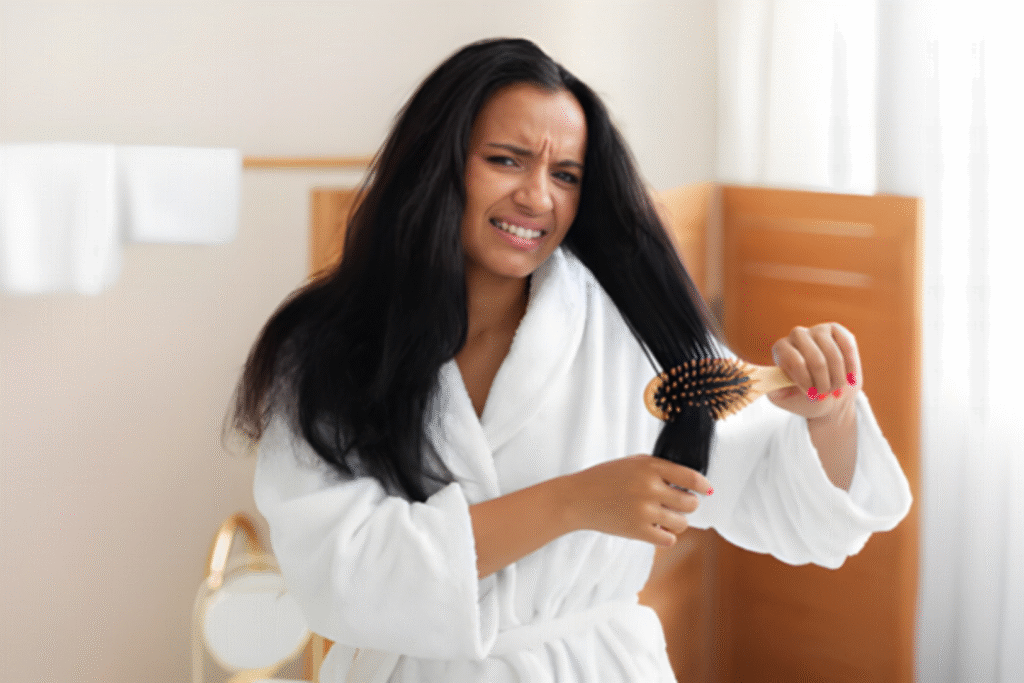
Many women with beautifully textured hair have embraced chemical relaxers for decades For generations, women with textured hair have turned to chemical relaxers for that sleek, polished look. While the results can be beautifully smooth, consistent relaxer use can sometimes come at a price — thinning edges, scalp sensitivity, and weakened strands. This delicate balance between beauty and scalp health has sparked a growing conversation about why relaxers affect the hairline and how to restore tresses safely. Today, we’ll explore the science behind relaxer-induced breakage, practical ways to regrow treated hair, and how protective styles like silk press hair extensions and relaxed hair extensions can support the recovery journey without compromising style.
How Relaxers Cause Hairline Thinning in Silk Press Extensions
Textured hair, known for its coily or wavy pattern, has a naturally fragile structure. Each twist and turn in the strand represents a potential weak point, making it more prone to dryness and breakage. Chemical relaxers work by breaking down the natural bonds in the hair shaft to straighten the curls. While this transformation gives a smoother appearance, it also strips away vital proteins and natural oils that protect the hair’s outer layer. Over time, this leads to weaker follicles — especially around the delicate hairline. When your edges are repeatedly exposed to harsh chemicals, heat, and tight hairstyles, they become the first area to show damage. The scalp’s natural barrier weakens, leading to inflammation, brittleness, and thinning. This is why many stylists now recommend limiting relaxer frequency and opting for more flexible styling alternatives. One gentle option is wearing Silk Press Hair Extensions, which allow textured hair to rest while maintaining a polished and natural look. These extensions blend seamlessly with straightened tresses without requiring additional chemical treatments. They offer versatility for those who want a smooth finish but are looking to give their natural mane a much-needed recovery period from harsh relaxers.
To protect the hairline, remember:
- Always coat your edges with a protective base before relaxer application.
- Avoid scratching or washing your scalp 48 hours before relaxing.
- Hydrate regularly with protein and moisture-balancing treatments.
How to Regrow Chemically Treated Hair and Relaxed Extensions Safely
After years of chemical use, regrowing healthy strands requires patience and consistency. The first step is understanding that recovery starts at the scalp. Follicles damaged by lye or calcium hydroxide (common relaxer ingredients) need nourishment to reactivate growth.
Moisture-rich products, scalp massages with essential oils like rosemary and peppermint, and a balanced diet can stimulate circulation and encourage new growth. Dermatologists also recommend low-tension protective styles that minimize pulling at the edges. This is where Relaxed Hair Extensions can be a game-changer. They’re designed to mimic the appearance of chemically treated textures while allowing your natural hair to grow underneath. Unlike constant heat or chemical exposure, these extensions give your strands a chance to rest and rebuild strength. By blending effortlessly with your own relaxed or transitioning hair, they create the illusion of fullness without adding strain to the scalp.
Here’s what to keep in mind for safe regrowth:
- Trim regularly to remove weak or split ends.
- Alternate between protein and moisture treatments every few weeks.
- Use sulfate-free shampoos to prevent further dryness.
- Keep your scalp clean to promote follicle activity.
When combined with protective styling and proper hydration, these practices can help restore your hairline and rebuild healthy, resilient tresses.
Finding the Right Balance: How Often Should You Apply Relaxers?
One of the most common questions stylists hear is, “How often should I relax my hair without causing damage?” The answer varies based on your texture and growth rate, but the general rule is every 8 to 12 weeks. Applying relaxers too frequently can lead to overlapping — when new growth and previously relaxed hair are processed together, doubling the damage.
Signs you’re relaxing too soon include:
- Increased breakage or shedding
- Persistent scalp burning or flaking
- Dry, brittle strands that snap easily
To avoid these issues, focus on stretching your relaxer schedule. The longer you go between applications, the better your mane can recover its natural oils. Incorporating protective styles like silk presses, braid extensions, or clip-ins allows you to maintain a sleek look without relying on chemicals as often.
Stylists also suggest periodic “relaxer breaks” — months where you forgo chemical treatments entirely. During this time, prioritize deep conditioning, scalp care, and protein treatments to rebuild elasticity and strength.
Can Extensions Help or Harm Hair Growth?
Extensions can be a blessing or a setback depending on how they’re applied and maintained. When used correctly, they act as a protective barrier, shielding natural hair from daily manipulation and environmental stressors. However, if installed too tightly or left in too long, they can pull on the follicles and worsen thinning edges.
To ensure extensions support growth:
- Always have them installed by a professional.
- Keep the scalp clean and moisturized.
- Avoid excessive tension or heavy weaves that strain the roots.
- Give your natural hair regular breaks between installations.
The key is balance — using extensions as a complement to your recovery routine, not a replacement for healthy hair practices.
FAQs
1. Why do relaxers cause thinning around the hairline?
Relaxers contain chemicals that break the disulfide bonds in textured hair. This process weakens the strand structure, especially at the edges where the scalp is most sensitive. Over time, this leads to breakage and thinning.
2. What are the safest ways to regrow relaxed hair?
Focus on scalp health through hydration, massage, and protein treatments. Avoid overlapping relaxers and consider low-tension protective styles to give your hairline time to recover.
3. Can extensions help or hurt the regrowth process?
When used properly, extensions can protect fragile strands by reducing daily manipulation. However, tight installations or lack of scalp care can lead to traction alopecia, worsening hair loss.
4. How often should I relax my hair?
Wait at least 8 to 12 weeks between treatments. This ensures only new growth is processed, minimizing the risk of overlapping damage.
Final Thoughts
Relaxers don’t have to spell disaster for your edges — it’s all about smart, informed care. Understanding how chemical treatments affect your textured mane helps you make better choices for long-term growth and strength. Whether you’re embracing a restorative journey with silk press hair extensions or giving your scalp a break using relaxed hair extensions, balance and consistency remain the golden rules for healthy, flourishing tresses.
